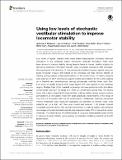Using low levels of stochastic vestibular stimulation to improve locomotor stability
Author(s)
Mulavara, Ajitkumar P.; Kofman, Igor S.; De Dios, Yiri E.; Miller, Chris; Peters, Brian T.; Goel, Rahul; Bloomberg, Jacob J.; Galvan, Raquel Christine; ... Show more Show less
DownloadMulavara-2015-Using low levels of.pdf (1.412Mb)
PUBLISHER_CC
Publisher with Creative Commons License
Creative Commons Attribution
Terms of use
Metadata
Show full item recordAbstract
Low levels of bipolar binaural white noise based imperceptible stochastic electrical stimulation to the vestibular system (stochastic vestibular stimulation, SVS) have been shown to improve stability during balance tasks in normal, healthy subjects by facilitating enhanced information transfer using stochastic resonance (SR) principles. We hypothesize that detection of time-critical sub-threshold sensory signals using low levels of bipolar binaural SVS based on SR principles will help improve stability of walking during support surface perturbations. In the current study 13 healthy subjects were exposed to short continuous support surface perturbations for 60 s while walking on a treadmill and simultaneously viewing perceptually matched linear optic flow. Low levels of bipolar binaural white noise based SVS were applied to the vestibular organs. Multiple trials of the treadmill locomotion test were performed with stimulation current levels varying in the range of 0–1500 μA, randomized across trials. The results show that subjects significantly improved their walking stability during support surface perturbations at stimulation levels with peak amplitude predominantly in the range of 100–500 μA consistent with the SR phenomenon. Additionally, objective perceptual motion thresholds were measured separately as estimates of internal noise while subjects sat on a chair with their eyes closed and received 1 Hz bipolar binaural sinusoidal electrical stimuli. The optimal improvement in walking stability was achieved on average with peak stimulation amplitudes of approximately 35% of perceptual motion threshold. This study shows the effectiveness of using low imperceptible levels of SVS to improve dynamic stability during walking on a laterally oscillating treadmill via the SR phenomenon.
Date issued
2015-08Department
Massachusetts Institute of Technology. Department of Aeronautics and AstronauticsJournal
Frontiers in Systems Neuroscience
Publisher
Frontiers Research Foundation
Citation
Mulavara, Ajitkumar P., Igor S. Kofman, Yiri E. De Dios, Chris Miller, Brian T. Peters, Rahul Goel, Raquel Galvan-Garza, and Jacob J. Bloomberg. “Using Low Levels of Stochastic Vestibular Stimulation to Improve Locomotor Stability.” Frontiers in Systems Neuroscience 9 (August 24, 2015).
Version: Final published version
ISSN
1662-5137